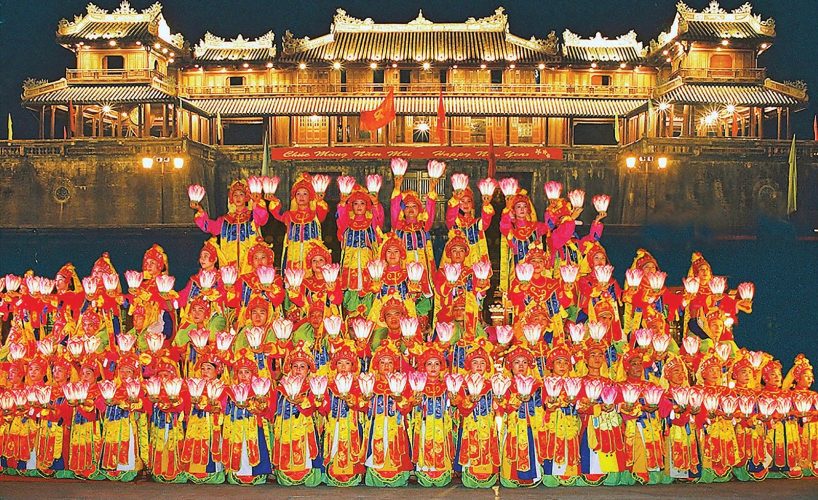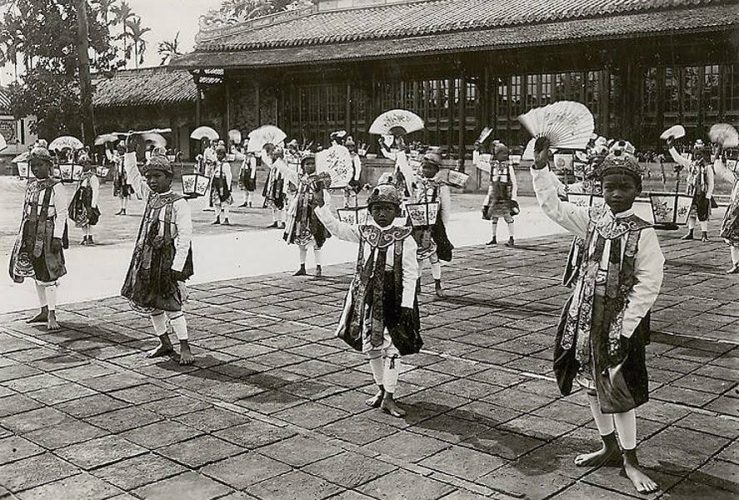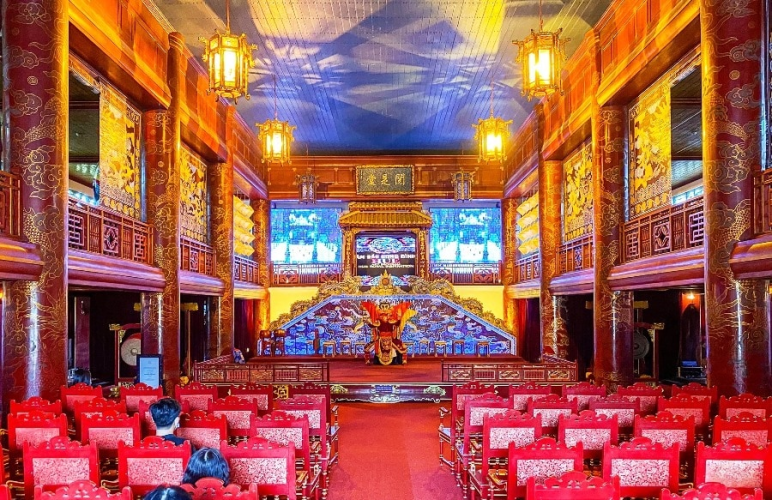Hue Royal Court Music: A Cultural Heritage of Vietnam
Hue Royal Court Music, a UNESCO-recognized intangible cultural heritage, is Vietnam’s pride and a magnet for global travelers. Its graceful melodies and sophisticated rhythms add a unique charm to the dreamy city of Hue.
Beyond exploring Nguyen Dynasty relics and the scenic Perfume River, immersing oneself in the harmonious notes of Hue Royal Court Music becomes an essential part of the adventure. It’s not just a cultural heritage; it’s a distinctive artistic expression that defines Vietnam.
A visit to Hue is more than a historical tour; it’s a chance to be captivated by the refined symphony of Hue Royal Court Music – an experience not to be missed.

Hue Royal Court Music: UNESCO Recognition and Cultural Eminence
The distinguished recognition of Hue Royal Court Music by UNESCO took place on November 7, 2003, marking a pivotal moment for cultural heritage. The official celebration of this recognition unfolded in the capital city of Paris, France, on January 31, 2004.
This accolade not only brought immense pride to Hue but also elevated Vietnam’s cultural standing on the global stage. It contributed significantly to the allure and unique charm of Hue’s ancient and poetic city, enhancing its appeal as a cultural destination.
Historical Development of Hue Royal Court Music
Under the Ly Dynasty

Hue Royal Court Music has its origins in the Ly Dynasty (1010 – 1225), characterized by refined melodies and sophisticated rhythms, symbolizing the survival, prosperity, and authority of feudal rulers.
During the Le Dynasty
In the Le Dynasty (1427 – 1788), this music form was reserved for the aristocracy and scholars, featuring complex structures with organized and detailed compositions. However, towards the end of the Le Dynasty, it faced a period of decline due to various reasons.
Nguyen Dynasty To The Present
Hue Royal Court Music experienced a revival during the Nguyen Dynasty (1802 – 1945), especially in the early 19th century under the reign of King Gia Long. It became an integral part of the imperial court, with standardized compositions and meticulous organization, laying the foundation for its development.

However, The colonization of Vietnam by the French and subsequent political upheavals cast shadows over this cultural gem. The abdication of the last Nguyen dynasty emperor, Bao Dai, in 1945 marked a poignant moment, triggering a gradual decline of royal court music.
In the face of challenges, a group of dedicated musicians and scholars emerged as guardians of this fading art. Despite the political transformations and societal shifts, they valiantly preserved and passed on the intricate knowledge and skills of Hue Royal Court Music to succeeding generations.
The turning point came in 2003 when UNESCO bestowed upon Hue Royal Court Music the prestigious title of a Masterpiece of the Oral and Intangible Heritage of Humanity. This recognition not only celebrated the art’s profound cultural significance but also elevated its status on the global stage.

The accolades continued in 2008 when Hue Royal Court Music was inscribed on the Representative List of the Intangible Cultural Heritage of Humanity. This dual UNESCO recognition not only acknowledges the resilience of the art form but also underscores its universal value, ensuring its safeguarding and continued appreciation worldwide.’
The Characteristics and Styles of Hue Royal Court Music
Dai Nhac and Tieu Nhac:
Hue Royal Court Music encompasses two main subtypes – Dai Nhac and Tieu Nhac.
- Dai Nhac: This grandiose form takes center stage during significant ceremonial occasions such as religious rituals, coronations, and funerals. Marked by a large-scale orchestra featuring around 40 different instruments, Dai Nhac creates a majestic ambiance.
- Tieu Nhac: In contrast, Tieu Nhac is more intimate, reserved for anniversaries, official receptions, and royal celebrations. Characterized by a smaller ensemble, it offers a nuanced and elegant performance.
About Instruments:

The music of the Hue royal court is characterized by a unique sound and style achieved through a diverse range of instruments, both traditional and foreign. These instruments are grouped into four categories: string, wind, percussion, and vocal:
- String instruments in this genre comprise the dan bau (monochord zither), dan tranh (16-string zither), dan nguyet (moon-shaped lute), dan nhi (two-string fiddle), and dan tam thap luc (36-string hammered dulcimer).
- Wind instruments include the sao (bamboo flute), ken (double-reed pipe), trong (drum), and mo (wooden bell).
- The percussion section features instruments like the trong chau (big drum), trong com (rice drum), song loan (clapper), phach (wooden sticks), and dia (cymbals).
- Vocal instruments encompass the ca hue (Hue singing) style, a form of chamber music where solo or duet singers are accompanied by a small ensemble of string and wind instruments.
The Best Places and Times to Watch Hue Royal Court Music Performances
Duyet Thi Duong Theatre
- Location: Inside the Hue Imperial Citadel
- Atmosphere: Majestic, solemn, and steeped in history
- Ticket price: 100,000 VND( $4)
- Opening hours: 10:00 – 10:40 and 15:00 – 15:40

The 200-year-old Duyet Thi Duong Theatre, nestled within the Hue Imperial Citadel, stands as a living testament to the cultural legacy of Vietnam. Here, you can witness not only Hue Royal Court Music but also folk dances and classical opera.
Perfume River Boat Rides:
- Location: Perfume River
- Atmosphere: Serene, surrounded by natural beauty
- Best Time: Evenings, during sunset or special river festivals

For a unique and picturesque encounter with Hue Royal Court Music, consider a boat ride on the Perfume River. The soothing sounds resonate against the backdrop of the river’s gentle flow and lush surroundings. This immersive experience allows you to enjoy the performance while drifting along the historic waterway.
Nghinh Luong Dinh Relic Site:
- Location: Hue City
- Atmosphere: Vibrant, community-oriented
- Best Time: Every Saturday from 17:00 to 18:00

The Hue Academy of Music hosts regular performances of Nha Nhac at the Nghinh Luong Dinh relic site. Every Saturday evening, visitors can enjoy the melodies of Hue Royal Court Music in a more casual setting, surrounded by the vibrant energy of the local community.
The Tips and Etiquettes for Enjoying Hue Royal Court Music
To fully appreciate the richness of Hue Royal Court Music, it’s essential to observe certain tips and etiquettes that enhance the overall experience. Here’s a guide to ensure you make the most out of this cultural journey:
- Dress Respectfully: As Hue Royal Court Music is a formal and esteemed art, opt for modest attire. Avoid clothing like shorts, skirts, sandals, hats, or sunglasses that may appear too casual or flashy.
- Punctuality Matters: Arrive on time and stay for the entire performance. The structure of royal music follows a sequence, and being punctual ensures you grasp the full artistic narrative. Avoid late arrivals, early exits, or moving around during the performance to maintain the solemn atmosphere.
- Silence Electronic Devices: Switch off or silence your electronic devices, including phones, cameras, or recorders. The delicacy of royal music demands a quiet and subtle environment. Any noise, flash, or vibration can disrupt the performance and affect its quality.
- Applause at the Right Time: Save your applause for the appropriate moments. Hue Royal Court Music often features intervals or specific pauses where applause is fitting. Follow the lead of the locals or cues from the performance to express your appreciation.
Hue Royal Court Music is the priceless intangible cultural heritage of the ancient capital region in particular and the Vietnamese people in general. If you are a devotee of exploring unique cultures, try visiting Hue once and enjoy this unique melody.
Relate blog
Relate blog

Bowling isn’t just a game; it’s an experience that brings friends and families together for fun-filled evenings. In the bustling…

The threat of pickpocketing is an ever-present concern for travelers exploring Vietnam. No one can predict when they might fall…

Discover Elephant Waterfall Dalat – one of the most beautiful waterfalls in Vietnam, where you can enjoy the pristine and…

